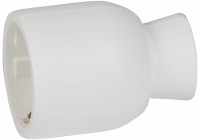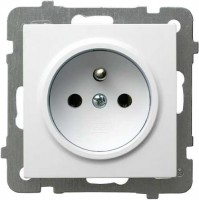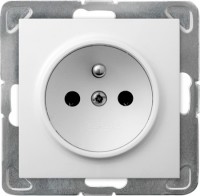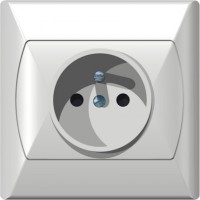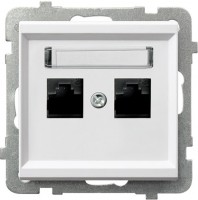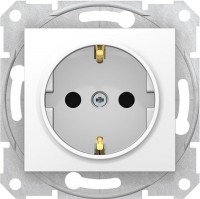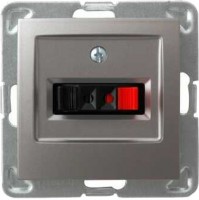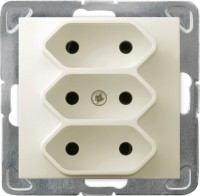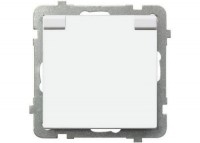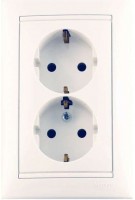Sockets Simon
All Sockets Advanced filters → |
You might be interested in
Sockets: specifications, types
Features
— Electric. The connection is represented by a plug connection. This is an ordinary plug that is attached to the current-carrying wire of the consumer of electricity. There are many types of power outlets. Both single and double (triple) models are widely used. Manufacturers of electrical equipment offer traditional and "smart" (smart) sockets. Some models of classic (traditional) sockets are equipped with a built-in programmer.
— Computer (RJ45). The computer socket uses an Ethernet connector, under the RJ45 connector. With its help, you can connect computer or other digital equipment to a local network (home or corporate) and access the Internet. Usually, sockets of this type are mounted next to the desktop or in the place of stationary placement of digital / peripheral equipment. Often a computer outlet is used to connect cable television or IPTV. The vast majority of models use a built-in design (flush-mounted), although some electrical manufacturers still produce surface-mounted outdoor RJ45 sockets.
— Telephone. Telephone sockets use an RJ11 or RJ12 connector. With the help of sockets of this type, stationary city telephones are connected, as well as devices of an internal telephone line (corporate). Additionally, telephone sockets can be used for ADSL Internet connection. Usually, models of this type are mounted near the installation site of fixed telephones, as well as routers...(routers) with an ADSL connection.
— Computer + phone. Combined sockets. The contact group, as well as the front decorative surface, is designed to install several different types of connectors (RJ45 + RJ11), more details about each of them can be found in the relevant paragraphs. Sockets of this type are often installed near the desktop.
— Computer + TV. The socket is equipped with heterogeneous interfaces: RJ-45 and coaxial TV connector. Designed for installation next to a multimedia entertainment system, which necessarily includes a TV and auxiliary digital/computer equipment (game console, media player, etc.). The TV connector is used to transmit a television signal, and the RJ-45 interface is designed to access the Internet or connect to a local network. In some cases, an RJ-45 computer connector can be used to transmit an IPTV television signal.
— Electricity + USB. Sockets of this type are designed for both traditional plug-in connection and connection using a USB port. The plug + USB combination allows the product to serve a wide range of devices, including gadgets and digital devices, which often do not have a fixed current-carrying wire with a plug.
— USB. USB sockets are designed to charge smartphones, tablets and other computer/digital devices. Depending on the specific model, the product may have 2-4 USB connectors for connecting several devices at the same time. There are models on the market for both flush-mounted and surface-mounted installations. Often, a USB connector is combined with a traditional plug connection (combined sockets).
— HDMI. The HDMI (High-Definition Multimedia Interface) interface is designed to transmit high-definition multimedia data. An HDMI socket allows you to neatly and practically connect the elements of a home theater or entertainment centre — it can be a large-screen TV and a computer. Usually, they are mounted in places where the screen and media library server are permanently placed. The vast majority of models are built-in and installed in mounting boxes.
— Audio. Audio sockets allow you to aesthetically, reliably and safely connect the main elements of the sound path of a home theater, stereo or multimedia system. Using audio sockets, you can connect speakers to an amplifier or directly to a sound source (player, music centre, DVD player, etc.).
— Audio-video (AV). Sockets with composite RCA connectors for audio and video signal connection. At this time, in the era of digital devices, it is considered an outdated way to connect AV equipment.
— Television TV. TV is a terrestrial television broadcast transmission standard. Television sockets TV use an analogue signal received from a radio antenna, which can operate in both the metre and decimetre frequency ranges. When choosing a socket of this type, the type of electrical accessories should be taken into account. There are through and end sockets. In addition, it is necessary to take into account the connection scheme (stub or "asterisk").
— Television SAT. SAT is an interface for transmitting a satellite television signal. SAT television outlets use a digital signal from a satellite dish. The SAT broadcasting standard operates in the 950-2400 MHz frequency range. Usually, the SAT signal is broadcast without interference; if the satellite signal strength is insufficient, the channel is blocked. There are pass-through and terminal SAT-sockets. The SAT interface is often combined with other television and radio broadcasting connectors, TV and R.
— Television TV-SAT. Combined sockets that allow you to use the signal from both traditional antennas for terrestrial broadcasting (TV) and satellite dishes (SAT). Television sockets TV-SAT are most often installed on those objects that are equipped with various types of antennas (metre / decimetre + satellite). They can be both passing and terminal. The tandem of TV-SAT interfaces can be supplemented with a connector for connecting FM/AM radio.
— Television TV-R. TV sockets TV-R work both with a signal from a classic metre / decimetre antenna, and with a signal from an AM / FM radio antenna. It is advisable to use the TV-R socket when the TV, player or receiver is equipped with a radio tuner. There are several types: through and terminal. TV outlets can be additionally equipped with a SAT satellite connector.
— Television TV-R-SAT. The combination of TV-R-SAT interfaces involves the use of signals from a metre / decimetre antenna, an AM / FM radio antenna and a satellite dish. Combined TV-R-SAT sockets are designed for installation in those facilities where a complete set of television and radio broadcasting antennas is used. When choosing a TV-R-SAT socket, you should pay attention to the design of the electrical fittings. There are through and end models.
— Computer (RJ45). The computer socket uses an Ethernet connector, under the RJ45 connector. With its help, you can connect computer or other digital equipment to a local network (home or corporate) and access the Internet. Usually, sockets of this type are mounted next to the desktop or in the place of stationary placement of digital / peripheral equipment. Often a computer outlet is used to connect cable television or IPTV. The vast majority of models use a built-in design (flush-mounted), although some electrical manufacturers still produce surface-mounted outdoor RJ45 sockets.
— Telephone. Telephone sockets use an RJ11 or RJ12 connector. With the help of sockets of this type, stationary city telephones are connected, as well as devices of an internal telephone line (corporate). Additionally, telephone sockets can be used for ADSL Internet connection. Usually, models of this type are mounted near the installation site of fixed telephones, as well as routers...(routers) with an ADSL connection.
— Computer + phone. Combined sockets. The contact group, as well as the front decorative surface, is designed to install several different types of connectors (RJ45 + RJ11), more details about each of them can be found in the relevant paragraphs. Sockets of this type are often installed near the desktop.
— Computer + TV. The socket is equipped with heterogeneous interfaces: RJ-45 and coaxial TV connector. Designed for installation next to a multimedia entertainment system, which necessarily includes a TV and auxiliary digital/computer equipment (game console, media player, etc.). The TV connector is used to transmit a television signal, and the RJ-45 interface is designed to access the Internet or connect to a local network. In some cases, an RJ-45 computer connector can be used to transmit an IPTV television signal.
— Electricity + USB. Sockets of this type are designed for both traditional plug-in connection and connection using a USB port. The plug + USB combination allows the product to serve a wide range of devices, including gadgets and digital devices, which often do not have a fixed current-carrying wire with a plug.
— USB. USB sockets are designed to charge smartphones, tablets and other computer/digital devices. Depending on the specific model, the product may have 2-4 USB connectors for connecting several devices at the same time. There are models on the market for both flush-mounted and surface-mounted installations. Often, a USB connector is combined with a traditional plug connection (combined sockets).
— HDMI. The HDMI (High-Definition Multimedia Interface) interface is designed to transmit high-definition multimedia data. An HDMI socket allows you to neatly and practically connect the elements of a home theater or entertainment centre — it can be a large-screen TV and a computer. Usually, they are mounted in places where the screen and media library server are permanently placed. The vast majority of models are built-in and installed in mounting boxes.
— Audio. Audio sockets allow you to aesthetically, reliably and safely connect the main elements of the sound path of a home theater, stereo or multimedia system. Using audio sockets, you can connect speakers to an amplifier or directly to a sound source (player, music centre, DVD player, etc.).
— Audio-video (AV). Sockets with composite RCA connectors for audio and video signal connection. At this time, in the era of digital devices, it is considered an outdated way to connect AV equipment.
— Television TV. TV is a terrestrial television broadcast transmission standard. Television sockets TV use an analogue signal received from a radio antenna, which can operate in both the metre and decimetre frequency ranges. When choosing a socket of this type, the type of electrical accessories should be taken into account. There are through and end sockets. In addition, it is necessary to take into account the connection scheme (stub or "asterisk").
— Television SAT. SAT is an interface for transmitting a satellite television signal. SAT television outlets use a digital signal from a satellite dish. The SAT broadcasting standard operates in the 950-2400 MHz frequency range. Usually, the SAT signal is broadcast without interference; if the satellite signal strength is insufficient, the channel is blocked. There are pass-through and terminal SAT-sockets. The SAT interface is often combined with other television and radio broadcasting connectors, TV and R.
— Television TV-SAT. Combined sockets that allow you to use the signal from both traditional antennas for terrestrial broadcasting (TV) and satellite dishes (SAT). Television sockets TV-SAT are most often installed on those objects that are equipped with various types of antennas (metre / decimetre + satellite). They can be both passing and terminal. The tandem of TV-SAT interfaces can be supplemented with a connector for connecting FM/AM radio.
— Television TV-R. TV sockets TV-R work both with a signal from a classic metre / decimetre antenna, and with a signal from an AM / FM radio antenna. It is advisable to use the TV-R socket when the TV, player or receiver is equipped with a radio tuner. There are several types: through and terminal. TV outlets can be additionally equipped with a SAT satellite connector.
— Television TV-R-SAT. The combination of TV-R-SAT interfaces involves the use of signals from a metre / decimetre antenna, an AM / FM radio antenna and a satellite dish. Combined TV-R-SAT sockets are designed for installation in those facilities where a complete set of television and radio broadcasting antennas is used. When choosing a TV-R-SAT socket, you should pay attention to the design of the electrical fittings. There are through and end models.
In box
— Socket (module assembly). The assembled module assumes the use of both an electrical contact group and a decorative panel (front frame). Some sockets are additionally equipped with a mounting box. Assembled sockets are completely ready for installation in a mounting box. Electrical fittings of this type are convenient in that when choosing it, there is no need to separately select the front decorative panel.
— Socket without a frame. Sockets without a frame are equipped with an electrical contact group and a front decorative panel, and the user must order the front decorative frame separately. Usually, frameless sockets are ordered when certain requirements are imposed on the design of electrical fittings. Thus, the customer has the opportunity to choose the version of the front panel that will most successfully harmonize with the interior of the room where the socket will be mounted. Manufacturers of frameless sockets also offer a wide range of individual faceplates that are fully compatible with the electrical contact group.
— Mechanism only. The socket is represented only by an electrocontact group and is devoid of a front decorative panel. This option is more suitable for cases where the user already has a front panel that is fully compatible with the design of the electrocontact group. Some socket manufacturers offer a wide selection of front de...corative panels for their products, so you can choose various lining options for a separately sold electrical contact group. In this case, the user has the choice of which decorative panel to install on the socket so that its design matches the interior of the room.
— Socket without a frame. Sockets without a frame are equipped with an electrical contact group and a front decorative panel, and the user must order the front decorative frame separately. Usually, frameless sockets are ordered when certain requirements are imposed on the design of electrical fittings. Thus, the customer has the opportunity to choose the version of the front panel that will most successfully harmonize with the interior of the room where the socket will be mounted. Manufacturers of frameless sockets also offer a wide range of individual faceplates that are fully compatible with the electrical contact group.
— Mechanism only. The socket is represented only by an electrocontact group and is devoid of a front decorative panel. This option is more suitable for cases where the user already has a front panel that is fully compatible with the design of the electrocontact group. Some socket manufacturers offer a wide selection of front de...corative panels for their products, so you can choose various lining options for a separately sold electrical contact group. In this case, the user has the choice of which decorative panel to install on the socket so that its design matches the interior of the room.
Mount
— Hidden (in the mounting box). The socket for concealed installation is placed in a mounting box, which in turn is built into the wall. Concealed mounting allows you to place the outlet flush with the wall surface, such models are in perfect harmony with any interior, for which they are appreciated. Flush-mounted sockets are fixed connection points (power supply), so they cannot be easily moved from place to place and not dismantled.
— Outdoor. Outdoor socket outlets have their own housing and do not need to be placed in a mounting box. External sockets are used when it is not possible to embed an electrical contact group into the internal cavity of a brick / concrete wall. Usually, they are placed on surfaces (partitions) made of wood, plastic and other materials and fixed with self-tapping screws — eyelets for fasteners are provided on the body. To power an external outlet, wiring without flush mounting is most often used.
— Outer corner. Corner sockets are designed for surface mounting at the interface of walls (partitions), as well as at the interface of walls with the surface of a countertop or floor. The angular design involves placing the working plane of the outlet at an angle of 45˚. In this position, it is possible to conveniently and safely connect / disconnect the plug. Usually, a corner socket has at least 2 plugs. Additionally, it can be equipped with a switch.
...— On a DIN rail. DIN rail is a metal profile that allows you to securely and accurately mount various models of electrical accessories in one line. DIN-rail sockets are designed for installation in switchboards, electrical cabinets, etc. At their core, all sockets are external overhead models. The electrical contact group of such sockets is enclosed in a sealed housing. The DIN rail allows you to place sockets and other types of electrical accessories as closely as possible to each other. To eliminate gaps between electrical equipment, special liners / partitions are used.
— Outdoor. Outdoor socket outlets have their own housing and do not need to be placed in a mounting box. External sockets are used when it is not possible to embed an electrical contact group into the internal cavity of a brick / concrete wall. Usually, they are placed on surfaces (partitions) made of wood, plastic and other materials and fixed with self-tapping screws — eyelets for fasteners are provided on the body. To power an external outlet, wiring without flush mounting is most often used.
— Outer corner. Corner sockets are designed for surface mounting at the interface of walls (partitions), as well as at the interface of walls with the surface of a countertop or floor. The angular design involves placing the working plane of the outlet at an angle of 45˚. In this position, it is possible to conveniently and safely connect / disconnect the plug. Usually, a corner socket has at least 2 plugs. Additionally, it can be equipped with a switch.
...— On a DIN rail. DIN rail is a metal profile that allows you to securely and accurately mount various models of electrical accessories in one line. DIN-rail sockets are designed for installation in switchboards, electrical cabinets, etc. At their core, all sockets are external overhead models. The electrical contact group of such sockets is enclosed in a sealed housing. The DIN rail allows you to place sockets and other types of electrical accessories as closely as possible to each other. To eliminate gaps between electrical equipment, special liners / partitions are used.
Module size
— 1/2 place. Sockets with a typical size 1/2 are the most compact models of electrical accessories. The 1/2-place socket housing is not installed in a traditional junction box, but in a special socket box, which often cuts into the plinth or is built into the junction box.
— 2 places. 2-gang sockets have several sockets for connecting electrical appliances. In this case, the nests have one common body. The electrical contact group of sockets for 2 places is placed in a classic mounting box, while the decorative front frame itself is enlarged, which allows you to more or less freely turn on / off the plugs. Sockets of this type can combine dissimilar connectors: the plug connection can be supplemented with TV connectors, USB, audio ports, etc.
— 3 places. The 3-gang socket is represented by a long block. Built-in models of this type are installed in a non-standard size mounting box. Among the long sockets for 3 places, there are also overhead solutions that are fixed directly to the wall / partition or mounted on a mounting plate. Three-place sockets allow you to power many consumers, while there is no need to use tees and carriers. One of the places of a three-module socket can be reserved for a switch or a connector or connectors other than a plug connection (USB, HDMI, mini-Jack, etc.).
— 4 places. Usually, 4-gang sockets are used to service stationary workplaces and all kinds of technological lines, wher...e a wide range of electrical engineering is involved. Among the sockets of this type, there are both built-in and overhead models. Most often, models are designed only for plug-in connection. But there are 4-seater models, where one of the modules is reserved for the switch. Additionally, there are 4-way sockets, in which the plug connection is combined with other sockets: audio, TV, USB, HDMI, etc.
— 2 places. 2-gang sockets have several sockets for connecting electrical appliances. In this case, the nests have one common body. The electrical contact group of sockets for 2 places is placed in a classic mounting box, while the decorative front frame itself is enlarged, which allows you to more or less freely turn on / off the plugs. Sockets of this type can combine dissimilar connectors: the plug connection can be supplemented with TV connectors, USB, audio ports, etc.
— 3 places. The 3-gang socket is represented by a long block. Built-in models of this type are installed in a non-standard size mounting box. Among the long sockets for 3 places, there are also overhead solutions that are fixed directly to the wall / partition or mounted on a mounting plate. Three-place sockets allow you to power many consumers, while there is no need to use tees and carriers. One of the places of a three-module socket can be reserved for a switch or a connector or connectors other than a plug connection (USB, HDMI, mini-Jack, etc.).
— 4 places. Usually, 4-gang sockets are used to service stationary workplaces and all kinds of technological lines, wher...e a wide range of electrical engineering is involved. Among the sockets of this type, there are both built-in and overhead models. Most often, models are designed only for plug-in connection. But there are 4-seater models, where one of the modules is reserved for the switch. Additionally, there are 4-way sockets, in which the plug connection is combined with other sockets: audio, TV, USB, HDMI, etc.
TV socket
- Checkpoint. Pass-through TV sockets use a more complex connection scheme than classic terminal counterparts. The pass-through TV socket has an additional contact that allows you to transmit an antenna radio signal to an additional TV socket. Models of this type are used when two or more TVs work from one antenna. Of course, the quality of the antenna signal will decrease from outlet to outlet. As a rule, walk-through TV sockets are capable of serving up to 3-4 TVs from one antenna.
- Terminal. Terminal TV outlets use the simplest type of connection - one end-type television outlet serves one antenna. Designed for those objects where only one TV is used. TV sockets with a terminal device are distinguished by a high quality of antenna signal transmission. Often, these models are combined with plug-in counterparts, as well as USB and Ethernet (RJ45).
- Individual. An individual television socket is used to serve one single connection point; it will not be possible to transmit a signal from it to further connection points, as in the checkpoints. A model of this type also differs from terminal electrical accessories - if the terminal socket completes the radio signal distribution line between two or more connection points, then the individual one works to serve only one single connection point.
— Individual Male. Marking male ("father") indica...tes the type of contact connector. The male part is represented by a male connector. In the past, all television sockets were equipped with a male connector. Today, there is a large selection of sockets with a female connector (“mother”). When choosing a TV outlet with a male connector, you need to make sure that the TV cable will support a similar connection scheme.
- Individual Female. The marking female (“mother”) indicates the type of contact connector, which in this case is represented by a female contact. Television sockets with a female connector have appeared relatively recently. The standard is considered to be sockets with a male contact, and the departure from the standard was dictated more by marketing considerations, that is, in order to expand the range of electrical accessories. A TV socket with a female contact should be ordered if the original TV cable provides a suitable connection to the antenna.
- Terminal. Terminal TV outlets use the simplest type of connection - one end-type television outlet serves one antenna. Designed for those objects where only one TV is used. TV sockets with a terminal device are distinguished by a high quality of antenna signal transmission. Often, these models are combined with plug-in counterparts, as well as USB and Ethernet (RJ45).
- Individual. An individual television socket is used to serve one single connection point; it will not be possible to transmit a signal from it to further connection points, as in the checkpoints. A model of this type also differs from terminal electrical accessories - if the terminal socket completes the radio signal distribution line between two or more connection points, then the individual one works to serve only one single connection point.
— Individual Male. Marking male ("father") indica...tes the type of contact connector. The male part is represented by a male connector. In the past, all television sockets were equipped with a male connector. Today, there is a large selection of sockets with a female connector (“mother”). When choosing a TV outlet with a male connector, you need to make sure that the TV cable will support a similar connection scheme.
- Individual Female. The marking female (“mother”) indicates the type of contact connector, which in this case is represented by a female contact. Television sockets with a female connector have appeared relatively recently. The standard is considered to be sockets with a male contact, and the departure from the standard was dictated more by marketing considerations, that is, in order to expand the range of electrical accessories. A TV socket with a female contact should be ordered if the original TV cable provides a suitable connection to the antenna.
Attenuation
The fading effect is expressed in the weakening of the television signal. Attenuation is calculated in decibels (dB) for every 100 meters. The higher the attenuation value, the less quality the antenna signal will have when it is output to the TV. Terminal sockets have the lowest attenuation value, while through sockets use a more complex connection scheme, which leads to a multiple increase in the attenuation of the antenna radio signal.
The exact value depends on the signal transmission range, as well as the quality of the wire itself, connecting the antenna to the outlet. It is generally accepted that an antenna radio signal with an attenuation of 1-3 dB has the proper quality. But pass-through television outlets often have attenuation values of 10-15 dB and even more.
The exact value depends on the signal transmission range, as well as the quality of the wire itself, connecting the antenna to the outlet. It is generally accepted that an antenna radio signal with an attenuation of 1-3 dB has the proper quality. But pass-through television outlets often have attenuation values of 10-15 dB and even more.
Grounding
Sockets with grounding are intended for maintenance of industrial machinery and other equipment. The plug of equipment that requires grounding has an additional contact surface (grounding). Thanks to grounding, the socket protects the serviced equipment from short circuits and other power outages. To install models of this type, it is necessary that the electrical switchboard is equipped with a working ground terminal, and the power cable has an auxiliary conductor connected to ground in the switchboard.
Rated current
The current strength of the outlet determines how powerful the equipment it can power. A standard 16 A household outlet allows you to safely service equipment up to 3.52 kW. The maximum power of consumers is calculated by the formula: network voltage (220 V) * socket current.
In the past, standard household outlets used an amperage rating of 6.3 A. But over time, more electrical appliances have been used in homes, forcing manufacturers to raise the standard amperage rating. If you connect a splitter (carrying device) to a 16 A socket that serves equipment with a total power of over 3.52 kW, the socket may melt.
Sockets with a rated current of 25 and 32 A are intended for installation in production and industrial facilities. Typically they use a 3-phase 380 V network.
In the past, standard household outlets used an amperage rating of 6.3 A. But over time, more electrical appliances have been used in homes, forcing manufacturers to raise the standard amperage rating. If you connect a splitter (carrying device) to a 16 A socket that serves equipment with a total power of over 3.52 kW, the socket may melt.
Sockets with a rated current of 25 and 32 A are intended for installation in production and industrial facilities. Typically they use a 3-phase 380 V network.
Maximum power
The value of the maximum power of the outlet determines the total power of consumers that are powered from it.
This parameter is inextricably linked with the rated current of the outlet. So, an ordinary household socket with a rated current of 16 A is capable of servicing equipment with a power of up to 3.52 kW. The maximum power is determined by the formula: voltage (230 V) * rated current. So, for example, W = 220 * 16 = 3520 W. If more powerful equipment is connected to an outlet with a maximum power of 3.52 kW, the outlet will melt.
This parameter is inextricably linked with the rated current of the outlet. So, an ordinary household socket with a rated current of 16 A is capable of servicing equipment with a power of up to 3.52 kW. The maximum power is determined by the formula: voltage (230 V) * rated current. So, for example, W = 220 * 16 = 3520 W. If more powerful equipment is connected to an outlet with a maximum power of 3.52 kW, the outlet will melt.
Cable category
— CAT 5e. The CAT 5e connection specification calls for the use of a 4-pair twisted-pair cable. RJ45 connector is used for connection. The performance of the 5e standard reaches 100-125 MHz. Sockets for CAT 5e cable connection are designed to work in networks: 10BASE-T, 100BASE-TX (Fast Ethernet), and 1000BASE-T (Gigabit Ethernet). When connecting two pairs, the maximum data transfer rate is 100 Mbps. When connecting 4 pairs, the maximum data transfer rate increases to 1000 Mbps. Foil-shielded twisted-pair cable should be used to connect CAT 5e sockets. An example of the optimal cable for connection 5e is the KVPEf-5e 4x2x0.52 wire.
— CAT 6. The CAT 6 standard involves the use of a special type of twisted pair cable, which differs from the classic version in a reduced pitch of turns and thickened cores. This modification of the twisted pair can significantly reduce crosstalk and reduce system noise. The CAT 6 cable connection uses the 8P8C connector, which looks very similar to RJ45. CAT 6 cabling performance reaches 250-350 MHz. The CAT 6 specification supports the widest range of network connections: 10BASE-T, 100BASE-TX (Fast Ethernet), 1000BASE-T/1000BASE-TX (Gigabit Ethernet), and 10GBASE-T (10-Gigabit Ethernet). Laying a CAT 6 network costs 30-50% more than installing a CAT 5e cable line. But a CAT 6 connection provides better connection quality and more bandwidth. To connect CAT 6, you should use a twisted pair cable of a special modification. An example of...an optimal cable is the KVP-6 wire 4x2x0.57.
— CAT 5e/6. The CAT 5e/6 marking may indicate that the outlet uses either a 5e + 6 combo connection or a removable KeyStone module. In the case of a removable module, KeyStone for CAT 5e connection can be replaced with a similar KeyStone CAT 6 model.
— CAT 6. The CAT 6 standard involves the use of a special type of twisted pair cable, which differs from the classic version in a reduced pitch of turns and thickened cores. This modification of the twisted pair can significantly reduce crosstalk and reduce system noise. The CAT 6 cable connection uses the 8P8C connector, which looks very similar to RJ45. CAT 6 cabling performance reaches 250-350 MHz. The CAT 6 specification supports the widest range of network connections: 10BASE-T, 100BASE-TX (Fast Ethernet), 1000BASE-T/1000BASE-TX (Gigabit Ethernet), and 10GBASE-T (10-Gigabit Ethernet). Laying a CAT 6 network costs 30-50% more than installing a CAT 5e cable line. But a CAT 6 connection provides better connection quality and more bandwidth. To connect CAT 6, you should use a twisted pair cable of a special modification. An example of...an optimal cable is the KVP-6 wire 4x2x0.57.
— CAT 5e/6. The CAT 5e/6 marking may indicate that the outlet uses either a 5e + 6 combo connection or a removable KeyStone module. In the case of a removable module, KeyStone for CAT 5e connection can be replaced with a similar KeyStone CAT 6 model.
USB charge current
The maximum charging current can be from 0.5 to 3.4 A, depending on the modification of the USB socket. For comparison, a USB 2.0 computer port has a charging current of 0.5 A, while a USB 3.0 port charges devices with a current of up to 0.9 A.
If the USB socket uses 2 or more sockets, then the maximum charging current will be evenly distributed among the sockets to which the devices are connected. That is, a 2-amp USB socket with two sockets, from which devices are already powered, will allocate 1 A of charging current for each port.
The speed of charging devices depends on the strength of the charging current of the USB socket. Of course, the speed of recharging devices will also depend on the operating parameters of their power supply. If the PSU of the device has a limitation on the charging current of 2 A, then when connected to a 3-amp USB outlet, the gadget will use less than 2 A for charging.
If the USB socket uses 2 or more sockets, then the maximum charging current will be evenly distributed among the sockets to which the devices are connected. That is, a 2-amp USB socket with two sockets, from which devices are already powered, will allocate 1 A of charging current for each port.
The speed of charging devices depends on the strength of the charging current of the USB socket. Of course, the speed of recharging devices will also depend on the operating parameters of their power supply. If the PSU of the device has a limitation on the charging current of 2 A, then when connected to a 3-amp USB outlet, the gadget will use less than 2 A for charging.
Operation indicator
The outlet indicator can perform many functions, the specific purpose depends on the modification of the outlet. Among the most popular solutions we highlight:
Network Health — Many indicator sockets use a light bulb to indicate network health. If the indicator works, then you can safely connect the equipment to the power grid.
Night mode — the indicator allows you to determine the exact location of the outlet at night, provided that the room lighting is turned off or weak.
Connected appliance — the indicator works only at the moment when the consumer is connected to the outlet.
Network overload — the indicator notifies you about the operation of the fuse built into the outlet.
Network Health — Many indicator sockets use a light bulb to indicate network health. If the indicator works, then you can safely connect the equipment to the power grid.
Night mode — the indicator allows you to determine the exact location of the outlet at night, provided that the room lighting is turned off or weak.
Connected appliance — the indicator works only at the moment when the consumer is connected to the outlet.
Network overload — the indicator notifies you about the operation of the fuse built into the outlet.
Backlight
The backlight allows you to determine the exact location of the outlet in conditions of insufficient visibility. Additionally, the illumination of electrical accessories can also act as a night light. Sockets of this type are almost always equipped with a built-in light sensor that activates and deactivates the lighting of electrical accessories. LEDs are used for illumination, and it is powered directly from the electrical contact group of the socket.
Shielding
Shielding allows you to reduce the negative impact of pickups from nearby current-carrying wires and various electrical equipment. Thanks to the shielding, the signal transmitted through the outlet retains its true quality characteristics. Shielding is especially relevant for those sockets that work with radio and television broadcasting signals, as well as packet data transmission. So, shielding is most often equipped with television outlets, as well as computer / telecommunications. Additionally, shielding is often found in HDMI sockets and audio electrical accessories.
Protective shutters
Protective shutters block free access to the electrocontact group. To use an outlet with curtains, the user must first remove the curtains themselves. Models of this type are mainly intended for installation in facilities where there are small children. Protective curtains prevent cases when a child sticks thin metal objects (hairpins, needles, knitting needles, etc.) into the plug holes.
Protective cover
The protective cover significantly increases the degree of tightness of the outlet. Models with a protective cover are often installed outdoors, as well as in rooms with high humidity (bathrooms and shower rooms, for example). Additionally, the cover allows you to protect curious children from the electrical contact group of the socket. Usually, the protective cover is equipped with a torsion spring, which allows it to be pressed against the front panel with a sufficiently high force.
Protection level
The degree of protection of electrical appliances is regulated by the international standard IP (International / Ingress Protection Rating). The most commonly used protection standards for sockets are IP0, IP20, IP44, IP54, IP55 and IP67.
Only ordinary household sockets have no protection. Models of sockets from the IP20 category have basic protection against dust, but they are not protected against moisture. Sockets rated IP44 and above are capable of withstanding both dust and moisture. Models of this class can be safely installed in bathrooms and other rooms with a high level of humidity. Additionally, protection from IP44 and above allows you to use sockets on the street, under ventilated canopies.
Only ordinary household sockets have no protection. Models of sockets from the IP20 category have basic protection against dust, but they are not protected against moisture. Sockets rated IP44 and above are capable of withstanding both dust and moisture. Models of this class can be safely installed in bathrooms and other rooms with a high level of humidity. Additionally, protection from IP44 and above allows you to use sockets on the street, under ventilated canopies.
Wire connection
— Screw. A screw connection involves fixing each wire with a special plate, which is pressed against the bare part of the wire under the action of screwing in a bolt (screw). This type of connection, although considered obsolete today, is still often used even by manufacturers of advanced electrical accessories. The screw-type clamp allows you to control the clamping force of the wiring, but due to temperature instability, the threaded connections of the electrocontact group are subject to self-unwinding. This moment leads to a weakening of the clamping of the wiring and deterioration of the contact.
— Clamp. The self-clamping terminal fixes the bare part of the wire due to the force of the stretched spring. To connect the wire, you must first press the tab of the terminal clamp by hand, and releasing the tab, the clamp will securely fix the contact part of the wire. Wiring with clamps is considered a more modern and reliable solution than the classic screw fixing method, since the terminal clamps are not subject to self-loosening. Among the shortcomings, one can single out the impossibility of controlling the clamping force.
— Clamp. The self-clamping terminal fixes the bare part of the wire due to the force of the stretched spring. To connect the wire, you must first press the tab of the terminal clamp by hand, and releasing the tab, the clamp will securely fix the contact part of the wire. Wiring with clamps is considered a more modern and reliable solution than the classic screw fixing method, since the terminal clamps are not subject to self-loosening. Among the shortcomings, one can single out the impossibility of controlling the clamping force.
Max. connected wire section
For an ordinary household plug socket, wires with a cross section of 2.5 mm² are used. This type of wiring can withstand a power load of up to 3.5 kW for each of the outlets. Regarding sockets that serve large household appliances, their electrical contact group is designed for wires with a larger cross section.
Material
— Plastic. Plastic for sockets shows high resistance to ultraviolet radiation, is easy to clean and has a spectacular appearance. The vast majority of recessed outlets have a plastic cladding. Regarding outdoor models, almost all external (case) sockets are made in a plastic shell.
— Ceramics. The body of the socket, as well as its front panel and frame, are made of high-quality ceramic or porcelain. The main advantage of ceramics is high resistance to ultraviolet radiation, high and low temperatures. There are practically no scratches and scuffs on ceramics. But ceramics poorly tolerate shock loads. Many ceramic rosettes are decorated in a retro style. But among the ceramic electrical accessories there are also sockets with a classic modern design.
— Metal. Almost all sockets with a metal front panel belong to the design category. The metal harmonizes well with the interior in Hi-Tech style. Sockets with a metal front surface have not only a good design, but also a high level of practicality. After all, the metal does not require additional care, while the material has ultimate strength. The only restriction is the ban on installation in rooms with a high level of humidity, as well as on the street.
— Ceramics. The body of the socket, as well as its front panel and frame, are made of high-quality ceramic or porcelain. The main advantage of ceramics is high resistance to ultraviolet radiation, high and low temperatures. There are practically no scratches and scuffs on ceramics. But ceramics poorly tolerate shock loads. Many ceramic rosettes are decorated in a retro style. But among the ceramic electrical accessories there are also sockets with a classic modern design.
— Metal. Almost all sockets with a metal front panel belong to the design category. The metal harmonizes well with the interior in Hi-Tech style. Sockets with a metal front surface have not only a good design, but also a high level of practicality. After all, the metal does not require additional care, while the material has ultimate strength. The only restriction is the ban on installation in rooms with a high level of humidity, as well as on the street.
Execution
— Horizontal. The design of the socket provides the installation of electrical accessories in a horizontal plane. Plug connectors are located one after the other, in a row, horizontally. The advantage of the horizontal arrangement of sockets is the possibility of convenient supply of plug connections. Plugs will not interfere with each other when simultaneously connected to adjacent connectors.
— Vertical. The vertical design of the sockets provides the location of the plugs one above the other. The vast majority of built-in vertical sockets have less than 2 plugs. The fact is that in vertical sockets for 3, 4 or more seats, it is inconvenient to simultaneously connect middle plugs if the plugs have an L-shaped profile. Overhead vertical sockets with plugs turned at an angle of 45˚ are widely used. Such models are devoid of the disadvantages of embedded analogues. The angular arrangement of the plugs allows you to simultaneously connect an unlimited number of L-shaped plugs.
— Vertical. The vertical design of the sockets provides the location of the plugs one above the other. The vast majority of built-in vertical sockets have less than 2 plugs. The fact is that in vertical sockets for 3, 4 or more seats, it is inconvenient to simultaneously connect middle plugs if the plugs have an L-shaped profile. Overhead vertical sockets with plugs turned at an angle of 45˚ are widely used. Such models are devoid of the disadvantages of embedded analogues. The angular arrangement of the plugs allows you to simultaneously connect an unlimited number of L-shaped plugs.
Embedding depth
The insertion depth of the socket must correspond to the depth of the mounting box. Usually, the standard installation depth is 40 mm. But there are models with both smaller and larger installation depths. For example, narrow sockets require only 25 mm depth from the back box. Additionally, there is a series of sockets that require at least 60 or even 80 mm depth from the mounting box.
Frame thickness
This parameter is applicable to built-in electrical fittings. The thickness of the frame determines how much the outlet will protrude from the wall. In the average model, this figure is in the range of 7-10 mm. The thinner the frame, the more neat the socket will look.
Country of origin
In this case, the country of origin of the brand is indicated, and not the country of production. So, sockets that many consider German will belong to a completely different country. At the moment, the following countries are represented on the market: Germany, China, Poland, Turkey, France, Sweden.

